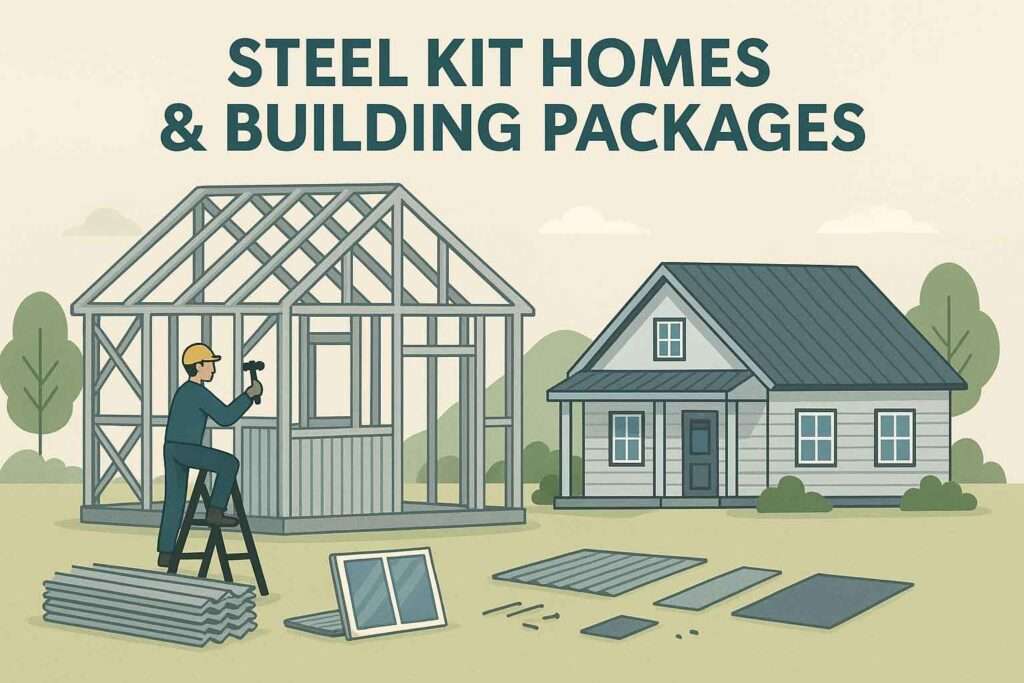
Building a home from the ground up has traditionally been seen as a time-consuming, expensive, and complex process. However, the rise of kit homes and building packages is changing that narrative. These cost-effective, customizable, and efficient housing options are gaining popularity across the U.S. and beyond. Whether you’re a first-time homebuyer, a downsizing retiree, or a rural landowner looking to develop your property, kit homes offer a smart solution that balances convenience and control.
In this blog post, we’ll explore what kit homes are, how building packages work, their pros and cons, and why they might be the ideal choice for your next home project.
What Are Kit Homes?
Kit homes, also known as prefabricated homes, package homes, or catalog homes, are houses sold in pre-designed packages that include most or all of the materials needed for construction. These kits typically include:
- Pre-cut lumber and framing
- Exterior sheathing and siding
- Roofing materials
- Interior walls
- Windows and doors
- Fasteners and hardware
- Plans and instructions
Think of a kit home as a large-scale, high-quality LEGO set for adults. All the components are precision-cut and labeled, ready to be assembled either by a contractor or (in some cases) by the homeowner themselves.
Types of Kit Homes
There are several types of kit homes, catering to different needs, aesthetics, and levels of complexity:
1. Panelized Homes
These homes come with wall panels that are manufactured off-site and shipped to your location. Panelized kits reduce construction time and waste and are easier to assemble than stick-built homes.
2. Modular Homes
Though technically a different category, modular homes are closely related. These are built in sections at a factory and assembled on-site. They offer the quickest assembly and are often indistinguishable from traditionally built homes.
3. Log Cabin Kits
Perfect for rural settings or vacation properties, log cabin kits come with precut logs, flooring, roofing, and instructions for a rustic, natural look.
4. Timber Frame Kits
These focus on heavy timber framing and open-concept designs. They’re popular for barndominiums and homes with exposed beams.
5. Tiny Home Kits
Designed for simplicity and affordability, these kits often come on wheels or foundations and are ideal for minimalist living or ADUs (Accessory Dwelling Units).
What Is a Building Package?
A building package is a broader term that includes all the materials and documentation needed to construct a building. While “kit home” implies a residential structure, building packages can be used for:
- Barndominiums
- Garages
- Workshops
- Barns
- Guest houses
- Sheds or storage units
Some building packages include turnkey services, such as architectural plans, delivery, and technical support. Others are strictly materials-only, offering more flexibility for customization and hiring local labor.
Benefits of Kit Homes & Building Packages
1. Cost Savings
One of the biggest advantages is affordability. Because materials are purchased in bulk, precut to size, and delivered in a single shipment, buyers can avoid many of the markups and delays associated with traditional builds. On average, kit homes can cost 20–40% less than site-built homes.
2. Faster Construction Time
With components ready to assemble, construction time can be drastically reduced. Some kit homes can be completed in as little as 2–3 months, compared to 6–12 months for traditional builds.
3. Simplified Planning
Kit homes come with blueprints and instructions, which can save thousands in architectural and engineering costs. Some kits also include permit-ready documentation.
4. Customization
Despite being “pre-designed,” most kit homes offer a high degree of customization. Buyers can often choose layouts, finishes, and even make structural changes during the design phase.
5. Energy Efficiency
Many kit homes are designed with sustainability in mind, using energy-efficient windows, insulation, and building methods that reduce environmental impact.
6. Remote Build Opportunities
Building packages are ideal for rural or off-grid properties where hiring a large construction crew may be impractical. Some owners even take the DIY approach to save on labor costs.
Things to Consider Before Buying a Kit Home
While kit homes offer many benefits, they also require careful planning and consideration. Here are a few potential challenges:
1. Permits and Regulations
Before purchasing a kit, check with your local building department. Zoning laws, setbacks, and permit requirements vary by location and can impact what types of structures are allowed.
2. Foundation Work
Most kits do not include the foundation, which must be poured or constructed separately. You’ll need to hire a local contractor or handle this part yourself.
3. Utilities and Site Prep
You’ll need to account for water, sewage/septic, electricity, and possibly internet. Site preparation (grading, access roads, drainage) also adds to the total cost.
4. DIY vs. Hiring a Contractor
While some homeowners take a hands-on approach, many hire local builders or general contractors to handle the assembly. This adds to the budget but ensures professional quality.
5. Shipping Costs
Some kits come with free delivery, while others may charge a significant fee based on location. Always factor this into your total project cost.
Who Are Kit Homes Ideal For?
Kit homes and building packages are suitable for a wide variety of homeowners and investors, including:
- First-time buyers looking for affordable housing
- Rural landowners developing secondary homes or cabins
- Investors building rental properties or Airbnb units
- Homesteaders and off-grid living enthusiasts
- Empty nesters downsizing into tiny homes or ADUs
- Families needing guest houses or multi-generational living spaces
Popular Kit Home Providers
While there are many companies across the country offering building packages, a few of the most trusted include:
- DC Structures – Known for barndominium kits and timber frame packages
- Summerwood Products – Specializes in small buildings and sheds
- Shelter-Kit – Offers customizable house kits, including hurricane-rated options
- Arched Cabins – Unique, steel-arched homes and cabin kits
- Bungalow in a Box – Craftsman-style home kits with eco-friendly materials
Always research your chosen provider, read customer reviews, and confirm that the design meets your local building code before purchasing.
Final Thoughts
Kit homes and building packages are no longer just niche options—they’re becoming mainstream solutions for those seeking affordable, efficient, and customizable home construction. As housing costs rise and the desire for alternative living spaces grows, more people are turning to these innovative systems to bring their dream homes to life.
Whether you’re looking to build a cozy cabin, a modern barndominium, or an off-grid retreat, kit homes provide a flexible and forward-thinking path to homeownership.
